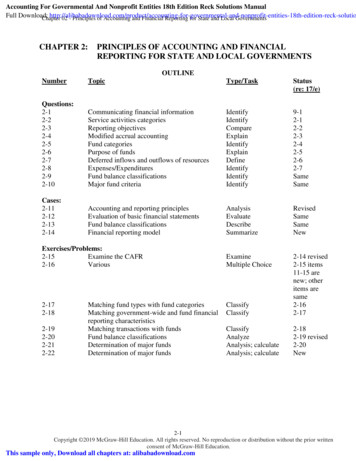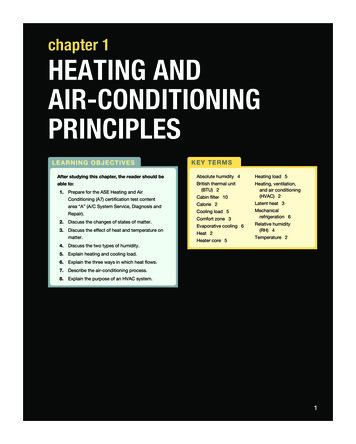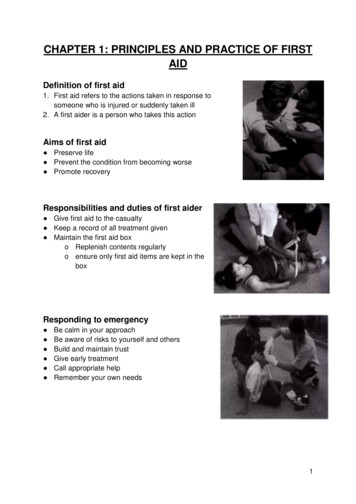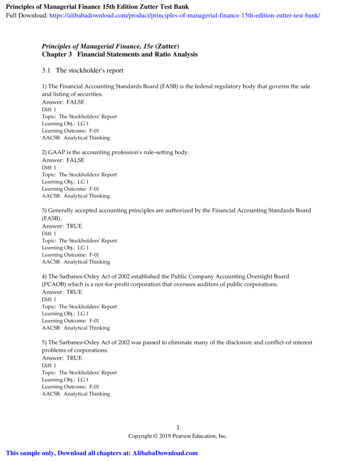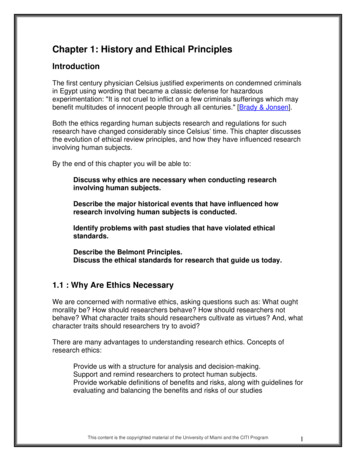
Transcription
CHAPTER 3PRINCIPLES OF ARMY WRITING STYLECHAPTER OBJECTIVE:When you have completed this lesson, you should be able to perform thefollowing tasks.TASK:Apply the principles of Army writing to improve your writing effectiveness.CONDITION:You will be given several questions regarding the rules of Army writing. Youmay use the instructional content of this lesson.STANDARD:You must accurately identify the principles of Army writing and how they applyto writing effectively.REFERENCES:AR 25-50, Preparing and Managing Correspondence and DA Pamphlet 600-67,Effective Writing for Army Leaders.3-1
CHAPTER 3PRINCIPLES OF ARMY WRITING STYLE1.INTRODUCTION. At various times soldiers will have to communicate their intention through writing.Putting our thoughts on paper is important, but just as important is to ensure that what we have written clearlycommunicates our intentions. Our understanding of "how to" organize our thoughts into coherent sentences andparagraphs can help ensure that we communicate clearly. The objective of this lesson, then, is to help you as a writersharpen your understanding of the Army writing style by briefly reviewing the structure and function of word groups(phrases, clauses, sentences, and paragraphs) to assist you in writing effectively.2.PRINCIPLES OF EFFECTIVE STYLE.a.Accuracy. Your work should represent only essential and accurate facts free of bias or distortion.b.Brevity and completeness. You must keep to essentials. Your writing should be brief and to thepoint. To cover a subject completely, while keeping the length of the paper to the absolute minimum requires carefulanalysis and probably several revisions. If necessary, attach explanatory facts and figures as annexes. The shorter yourpaper, the less your chance for error. On the other hand, never sacrifice clarity to gain brevity.c.Clarity. You must make a special effort to keep your writing clear and fully understandable. Yourreaders must be certain of your intent. Select words and phrases that express your exact meaning and can only haveone interpretation. Using familiar, precise words contributes to clarity in writing.d.Coherence. Coherence is the logical development and arrangement of a subject. You can achievecoherence by first thinking the subject through and seeing it as a whole, then arranging the various parts logically andharmoniously. When writing on a complex subject, use an outline to achieve coherence.e.Unity. Your writing must adhere to a single idea. You should apply this principle not only to eachsentence and paragraph but also to your entire paper. If you have more than one subject to discuss, prepare a separatepaper on each subject.3.PUT YOUR BOTTOM LINE UP FRONT.a.The purpose statement. Open with a short, clear purpose sentence. The purpose statement is not thesame as the bottom line. It only tells the reader what to expect when reading the paper. A purpose statement does nottell the reader the conclusion(s) the writer draws.b.Thesis. The bottom line or thesis statement tells your reader what it is you consider important. Putthe recommendation, conclusion, or most important information (the main point) next. (Some writers combine thepurpose and the main point.) The Army standard for writing requires putting the main point up front and using theactive voice. It is best to capture your bottom line in a single sentence that is clear and easy to understand. Being ableto state your thesis in a single sentence indicates that you have a good understanding of your subject. After you havestated your bottom line and explained it in the first paragraph, you are free to support your thesis. For example:Purpose:It is the purpose of this paper to discuss creating a fair and democratic electoral system forHaiti.3-2
Thesis:The proposed changes to the Haitian electoral system will ensure fair and democraticelections.c.Major parts. Introduce the major parts right after your thesis statement. This tells the reader howyou will develop support for your position.4.CLEAR AND CONCISE SENTENCES. A sentence consists of an arrangement of words to transmit athought. The words you select, their clarity, conciseness, and how you arrange them directly affects whether youraudience will understand your message. A clear and logical sentence is one that has both coherence and unity. Aconcise sentence expresses an idea with as few words as possible. Your written (and spoken) communication must beclear, direct, and understandable. The following guidelines will help you communicate clearly.a.Choose effective words and phrases. The words and phrases you choose directly affects the clarityand conciseness of each sentence. As you select the words and phrases for each sentence ask yourself, "Do these wordsand phrases effectively say what I want? Would my reader understand them?" If you can't answer yes, then you needto re-examine what you are trying to say.(1)Use concrete words. Concrete words are easy to understand because they relate to the fivesenses. For example, the term M16A2 is meaningful to a military audience because it represents an object that you cansee, feel, and use. Abstract words, on the other hand, are hard to understand because they fail to recall experiences ofthe five senses. Some language experts describe words in terms of an abstraction ladder.(a)The lower rungs of the ladder represent objects the reader can readily identify.They are concrete words.(b)As you go up the ladder, each word becomes more abstract than the one below. Atthe same time, the meaning becomes vague and open to debate. Such a ladder might look like this:ABSTRACTMATERIALINSTRUMENT OF WARWEAPONRIFLEM16A2 RIFLECONCRETEFigure 3 –1. Abstraction ladder.(2)Use common words. You will find that it is harder to write "gobbledygook" than simplelanguage because you must translate common words into uncommon, impressive sounding words. Many writers use"gobbledygook" because they believe it adds dignity to their writing.Gobbledygook is a catchword meaning that the writer uses (a) 100 words to say what could be said in 20; (b)words that are unfamiliar to the reader, (c) words of three or four syllables when simpler words convey the same idea;(d) military jargon or overworked phrases; (e) long and involved sentences; (f) foreign expressions; and (g) jumbled,unrelated, illogical ideas.3-3
Gobbledygook:Illumination is required to be extinguished upon vacating these premises.Improved:Turn out the lights when you leave.Gobbledygook:Hegemony is a basic characteristic of a good officer.Improved:Leadership is a basic characteristic of a good officer.Gobbledygook:An Army career offers you the opportunity to peregrinate in foreign countries.Improved:An Army career offers you the opportunity to travel in foreign countries.(3)Use familiar words. Some words cover such a broad field that the reader is unable to decidewhat you mean. Avoid vague, ambiguous words or ideas that obscure your topic. Consider the following examplewhere unrelated and distant words and ideas hide the real meaning.Wordy:These chapters on tests and measurements are presented with the hope theywill enable you to make full utilization of correct procedures and techniques.It is believed that you will find them of practical value in the event that you arecalled upon to administer tests or to interpret in the field the scores resultingfrom tests.The following rewrite of these two sentences clarifies the message by eliminating the unrelated and distant words andideas.Improved:In these chapters, we will teach you how to give tests and interpret test scores.You improve the clarity by finding the word that precisely expresses your thought. For example, consider thedistinction between rebellion and revolution. The two words are similar but different. Rebellion describes resistanceto or defiance of any authority, control, or tradition which may or may not result in change. Revolution, on the otherhand, describes a forcible overthrow of a government or a complete, usually radical change in something that occursrelatively quickly. Another comparison can be made between the words practicable and practical. Practicable appliesonly to that which is capable of being put into practice. Practical, as opposed to theoretical, means sensible whenapplied to persons, efficient when applied to things. The building of a pontoon bridge across a body of water might bepracticable (it could be done), but it would not be practical (sensible) unless it were the most efficient method ofconnecting the two shores.(4)Avoid wordiness. Use words that have meaning to your audience. Often our writing iscluttered with words that add nothing. We use words that could be omitted; we use phrases when a word would do.Learn to recognize this "excess baggage" and delete it from your writing. Following are three wordy sentences withexamples showing how you can improve them.Wordy:I contemplate inaugurating a reorganization of my company in the near future.Improved:I intend to reorganize my company soon.3-4
Wordy:In every instance wherein a change is necessary in a one-page pamphlet, thechange will be accomplished by a republication of the pamphlet.Improved:When changes are necessary in one- or two-page pamphlets we will republishthe pamphlets.Wordy:Needless to say, the discarded desk will be repaired in each instance.Improved:We will repair each discarded desk.(5)Avoid stilted words and phrases. Some words or phrases are used so exclusively in writingthat they have an artificial, stilted flavor; while you may need to use such words occasionally, try to find plain commonterms instead. Compare the following examples:ClearAnd so .Therefore .Now ., next .That is, .StiltedAccordingly ., consequently .Hence ., thus .Moreover .That is to say .(6)Avoid overworked words and phrases. Some words and phrases have become trite andtiresome. Ordinary and simple words attract by their simplicity and naturalness. Look for fresh but common wordsthat clearly communicate. Notice the difference between the following expressions.TriteMakes provision for .The fullest possible extent .For the reason that .Inasmuch as .In the event that .On the basis of .Fresh/CommonDoes .The most .Since .Since .If .By .(7)Don't bury your verbs. Verbs are relation-showing words. They show action (we go), state(he became), feeling (she likes), or existence (you are). A buried verb is one that has been hidden in other words.Buried verbs decrease the forcefulness of your writing while increasing the potential for misunderstanding. If you freethese verbs, they will add force to your writing. We bury verbs by adding the endings ance, ent, al, ing, ed, tion, sion,and age. Consider the following example:The need for investigation of the sounds became apparent to them.In this example the buried verbs are investigate in investigation and appear in apparent. If we free the buried verbs, wemight write the sentence as follows:The need to investigate the sounds appeared to them.Since the sentence is still awkward, we might say:Better:They saw that they needed to investigate the sounds.Best:They saw that they should investigate the sounds.b.Make sentences clear, concise, and logical. Limit each sentence to a single thought. A sentence thatincludes several unrelated ideas connected by words like “and” and “so” is hard to understand.3-5
Vague:The following individuals failed to make a qualifying score with the M16 rifle,so this course will be repeated during the last half of the current training cycle,and their schedules should be changed to include this instruction.Clear:The following people failed to qualify with the M16 rifle. They will repeatthis course during the last half of the training cycle.Arrange your words and phrases to convey your exact meaning. You do not need to be a grammarian to recognizeillogical sentence structure. Use common sense. When you have written a statement, ask yourself, "Is the meaning ofthe sentence clear when I read it rapidly?" If you can't answer "Yes," the sentence needs rewriting.(1)Avoid misused modifiers. Modifiers, whether they are words or phrases, should be near thewords they modify. If you use modifiers carelessly, you will confuse your reader. There are three general types ofmisused modifiers: dangling modifiers, misplaced modifiers, and ambiguous modifiers. Any of the three will lead toconfusion, as shown in the following examples.(a)Dangling modifier:Dangling:Driving quickly through the cane fields, the two positions were seized by the21st Infantry. (Driving cannot logically modify positions.)Should be:Driving quickly through the cane fields, the 21st Infantry seized the twopositions.(b)Misplaced modifier:Misplaced:Every soldier cannot become a general. (Modifies can become.)Clear:Not every soldier can become a general. (Modifies every.)Misplaced:Only the tank contained 2 gallons of gas. (Modifies tank.)Clear:The tank contained only 2 gallons of gas. (Modifies 2.)(c)Ambiguous modifier:Ambiguous:Inspectors will report any unauthorized use or misuse of equipment.(Unauthorized modifies both use and misuse.)Should be:Inspectors will report any misuse or unauthorized use of equipment.Ambiguous:All damaged equipment and scrap will be turned in to the property disposalofficer on Friday. (Damaged modifies both equipment and scrap.)Should be:All scrap and damaged equipment will be turned in to the property disposalofficer on Friday.(2)Watch for faulty pronoun references. A pronoun should be placed as near as possible to itsantecedent so that no intervening word is mistaken for the antecedent. If necessary repeat the antecedent to preventmisunderstanding. Further, pronouns should agree in number with the nouns to which they refer.3-6
Confusing:The sniper followed the scout into the woods, where he shot him. (Scoutwould probably be mistaken for the antecedent.)Should be:The sniper followed the scout into the woods and shot him.Confusing:Although w
sharpen your understanding of the Army writing style by briefly reviewing the structure and function of word groups (phrases, clauses, sentences, and paragraphs) to assist you in writing effectively. 2. PRINCIPLES OF EFFECTIVE STYLE. a. Accuracy. Your work should represent only essential and accurate facts free of bias or distortion. b. Brevity and completeness.File Size: 463KBPage Count: 13Explore furtherMSL 202, Lesson 15: Writing in the Army Style Writing in .www.jmu.eduManagement Preparing and Managing Correspondencearmypubs.army.milEFFECTIVE ARMY WRITING - United States Armyrdl.train.army.milPreparing and Managing Correspondence - United States Armyarmypubs.army.milPersonnel—General Effective Writing for Army Leaderswww.armywriter.comRecommended to you based on what's popular Feedback

